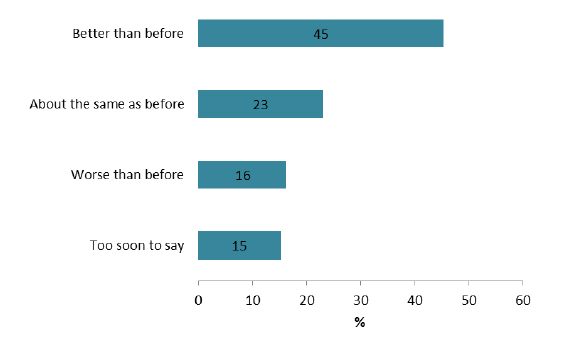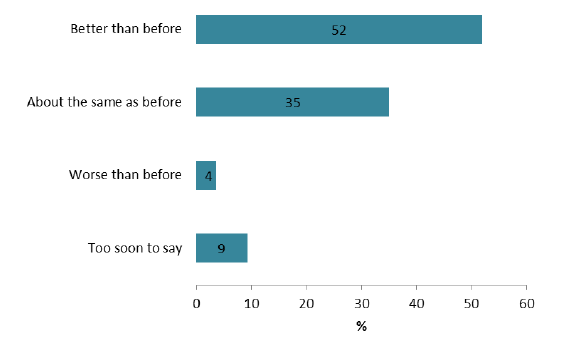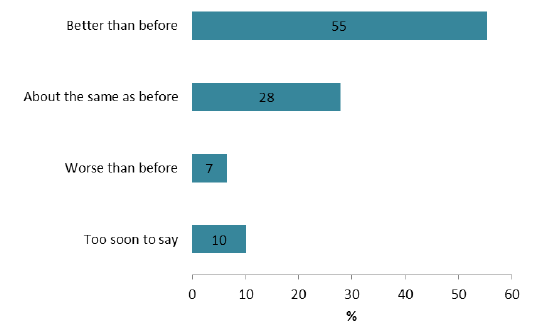Health and Care Experience Survey 2013/14 Volume 1: National Results
Results from the 2013/14 Health and Care Experience Survey.
This document is part of a collection
11 Outcomes From NHS Treatments
Introduction
11.1 One of the key actions identified in the Quality Strategy[14] was to "Improve and embed patient-reported outcomes and experience across all NHS Scotland services". Patient Reported Outcome Measures (PROMs) are recommended in the Quality Strategy for use across NHS Scotland for service improvement, as well as to track outcomes nationally as a quality outcome indicator.
11.2 This survey asks patients to report outcomes based around three dimensions of health status - pain, ability to do usual activities and anxiety/ depression. They ask people about their experience of the impact of treatment on these three dimensions separately. While it is recognised that people cannot easily quantify change in health status, they are able to identify whether or not they have experienced an improvement. The "too soon to say" option allowed an answer for people who have been treated but are not yet expected to see a benefit.
11.3 At the aggregate level these questions should give some measure of the impact of treatment. While the questions are not specific enough to be directly useful for local improvement (e.g. we do not know what treatments people have had, or where they had them), the results raise some interesting questions that merit further research with patients.
People's ability to do their usual activities
11.4 Respondents were asked if they had received NHS treatment or advice in the last year because of something that was affecting their ability to do their usual activities.
- 29 per cent of patients answered yes
11.5 Of patients who had sought treatment or advice, 45 per cent were able to go back to most of their usual activities. However 16 per cent were less able to do their usual activities (Figure 18).
Figure 18: The effect of treatment of patients' ability to do their usual activities

Pain or discomfort
11.6 Patients were asked if they had received NHS treatment or advice because of something that was causing them pain or discomfort.
- 53 per cent of patients answered yes
11.7 Of patients who had sought treatment or advice, 52 per cent reported that the effect of the treatment was to make them feel better than before (Figure 19).
Figure 19: The effect of treatment on pain or discomfort

Depression or anxiety
11.8 Patients were asked if they had received NHS treatment or advice because of something that was making them feel depressed or anxious.
- 16 per cent of patients answered yes
11.9 Of patients who had sought treatment or advice, 55 per cent reported that the effect of the treatment was to make them feel better than before (Figure 20).
Figure 20: The effect of treatment on depression or anxiety

Quality Outcome Indicator
11.10 The Quality Strategy emphasises the importance of measurement, and a Quality Measurement Framework has been developed[15] in order to provide a structure for describing and aligning the wide range of measurement work with the Quality Ambitions and Outcomes. As part of this framework, 12 national Quality Outcome Indicators have been identified, which are intended to show national progress towards achievement of the Quality Ambitions.
11.11 One of these twelve Quality Outcome Indicators relates to Patient Reported Outcomes. While initial proposals envisaged that this indicator would be built up from local patient feedback information, it was recognised that this would require long term development and that therefore a high level indicator should be captured using this national survey. It was first reported in the previous survey.
11.12 The indicator is based on the outcomes questions reported above and provides a single score for patient reported outcomes. Further information on how the indicator has been calculated is available in the technical report. It should be kept in mind that this indicator represents a score and not a percentage value.
11.13 The value of the Healthcare Experience Quality Outcome Indicator has remained steady since the previous survey, with the same score of 75.2. Only one NHS Board saw a statistically significant change in their score (Table 13).
Table 13: Outcome Indicator by NHS Board
| Outcomes |
95% Confidence interval |
Change since 2011/12 |
||
|---|---|---|---|---|
| Lower limit |
Upper limit |
|||
| NHS Ayrshire & Arran |
74.0 |
72.9 |
75.2 |
-0.1 |
| NHS Borders |
78.3 |
76.5 |
80.0 |
2.0 |
| NHS Dumfries & Galloway |
75.7 |
74.0 |
77.4 |
0.9 |
| NHS Fife |
74.9 |
73.8 |
76.0 |
0.7 |
| NHS Forth Valley |
74.9 |
73.7 |
76.0 |
-0.2 |
| NHS Grampian |
76.4 |
75.3 |
77.4 |
-0.7 |
| NHS Greater Glasgow and Clyde |
74.3 |
73.7 |
74.8 |
0.2 |
| NHS Highland |
77.4 |
76.4 |
78.4 |
-0.3 |
| NHS Lanarkshire |
73.3 |
72.5 |
74.2 |
-0.3 |
| NHS Lothian |
76.2 |
75.5 |
77.0 |
0.2 |
| NHS Orkney |
82.8 |
79.1 |
86.6 |
4.3 |
| NHS Shetland |
78.4 |
75.0 |
81.7 |
0.0 |
| NHS Tayside |
75.7 |
74.7 |
76.8 |
-0.1 |
| NHS Western Isles |
75.3 |
72.1 |
78.4 |
-4.1 |
| Scotland |
75.2 |
74.9 |
75.5 |
0.0 |
Contact
Email: Andrew Paterson
There is a problem
Thanks for your feedback